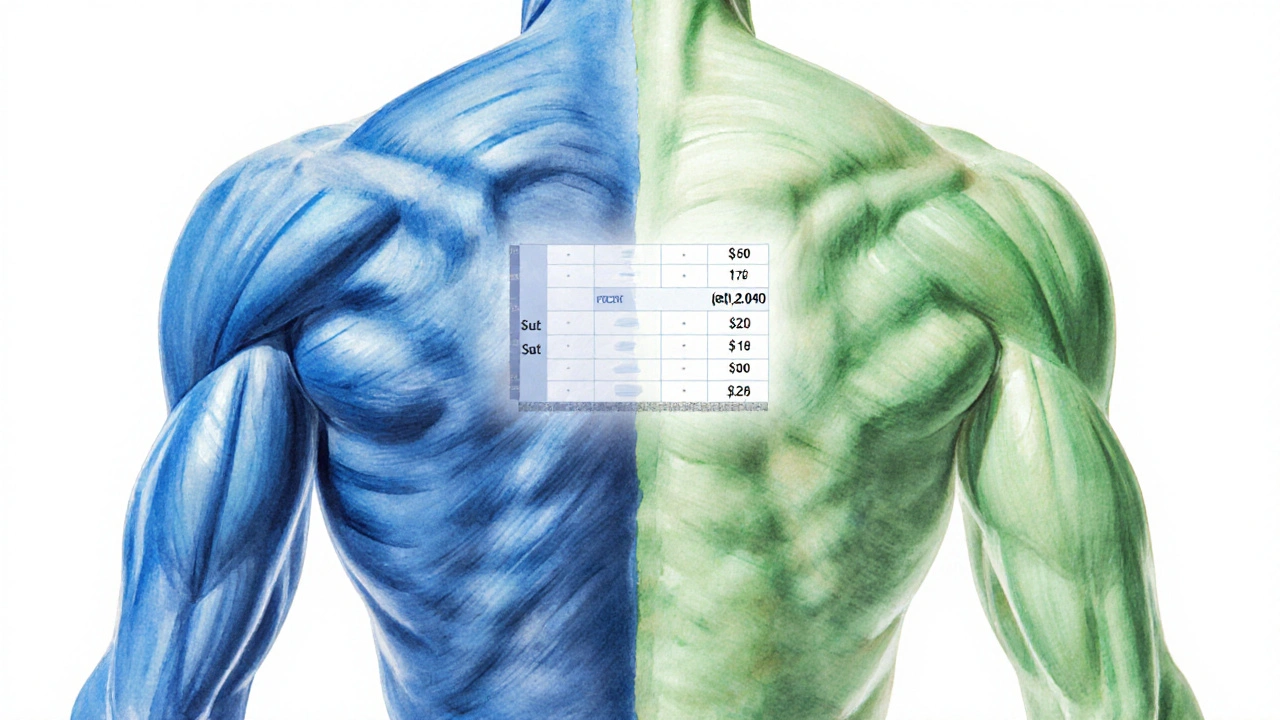- 15
Muscle Relaxant Selector
Select your symptoms and preferences to find the best muscle relaxant for you.
When a doctor prescribes a muscle relaxant, most patients wonder if there’s a better option for their pain or lifestyle. Zanaflex is the brand name for tizanidine, a short‑acting agent that eases spasticity and acute muscle spasms. This article breaks down how Zanaflex stacks up against the most common alternatives, so you can decide which drug (or non‑drug approach) fits your needs.
Key Takeaways
- Zanaflex works fast but may cause dry mouth and dizziness.
- Baclofen offers longer relief for chronic spasticity, but can make you sleepy.
- Cyclobenzaprine is good for short‑term use but has strong anticholinergic effects.
- Methocarbamol has a mild side‑effect profile, making it a safe starter.
- Carisoprodol carries a higher abuse risk and should be a last resort.
What Is Zanaflex?
Zanaflex is a prescription medication classified as an alpha‑2 adrenergic agonist. It reduces muscle tone by inhibiting nerve signals that cause spasticity. The drug comes in 2mg and 4mg tablets, typically taken 2-3 times a day. Onset of action is about 30‑60minutes, and the effects wear off after 4‑6hours, which is why many clinicians split the dose across the day.
How Zanaflex Works
The alpha‑2 receptors sit in the spinal cord. When Zanaflex binds, it dampens the release of excitatory neurotransmitters, leading to smoother muscle movement. Because it targets the central nervous system selectively, it often feels less “sedating” than older relaxants, though low blood pressure and dry mouth are common complaints.
Common Alternatives
Below are the five most frequently prescribed rivals. Each has a different mechanism, dosing schedule, and safety profile.
- Baclofen - a GABA‑B agonist that relaxes muscles by inhibiting spinal reflexes.
- Cyclobenzaprine - a tricyclic antidepressant derivative that blocks motor nerve impulses.
- Methocarbamol - a centrally acting relaxant with a relatively flat side‑effect curve.
- Carisoprodol - a pro‑drug that converts to meprobamate, a mild tranquilizer.
- Physical Therapy - non‑pharmacologic care that uses stretching, heat, and manual techniques to reduce spasm.

Side‑by‑Side Comparison
| Attribute | Zanaflex (Tizanidine) | Baclofen | Cyclobenzaprine | Methocarbamol | Carisoprodol |
|---|---|---|---|---|---|
| Mechanism | Alpha‑2 agonist | GABA‑B agonist | Tricyclic‑type nerve block | Central depressant | Pro‑drug to meprobamate |
| Typical dose | 2-4mg 2-3×/day | 5-10mg 3×/day (up to 80mg) | 5-10mg at bedtime | 500-1500mg 4×/day | 350mg 3×/day (max 2100mg) |
| Onset | 30‑60min | 1‑2h | 1‑2h | 30‑60min | 30‑45min |
| Duration | 4‑6h | 6‑12h | 4‑6h | 4‑6h | 4‑6h |
| Common side effects | Dry mouth, hypotension, drowsiness | Sleepiness, weakness, dizziness | Dry mouth, constipation, blurred vision | Drowsiness, nausea, dizziness | Dependency, drowsiness, GI upset |
| Contraindications | Severe liver disease, hypotension | Renal failure, seizure disorders | Recent MI, arrhythmia | Severe hepatic impairment | History of substance abuse |
| Typical cost (US) | $0.75‑$1.20 per tablet | $0.20‑$0.35 per tablet | $0.40‑$0.70 per tablet | $0.15‑$0.30 per tablet | $0.90‑$1.40 per tablet |
Choosing the Right Agent for You
Short‑acting relief matters when you need a quick fix for a post‑workout cramp or a flare‑up from an injury. Zanaflex shines here because it hits fast and clears out before bedtime, reducing night‑time drowsiness.
If you have chronic spasticity from multiple sclerosis or spinal cord injury, you’ll likely benefit from Baclofen’s longer half‑life and smoother day‑long control.
Patients who also battle depression or anxiety sometimes appreciate the dual effect of Cyclobenzaprine, though they must watch for anticholinergic side effects like constipation.
When safety is the top priority-such as in older adults-Methocarbamol provides a gentle profile with fewer cardiovascular concerns.
Reserve Carisoprodol for cases where other agents fail, because of its abuse potential and the need for tighter monitoring.
Finally, don’t overlook Physical Therapy. A tailored stretching program can cut the need for any pill by up to 30% in many low‑to‑moderate spasm cases.
Safety Checklist Before Switching
- Review liver function tests - Zanaflex is metabolized by CYP1A2; impaired liver raises blood levels.
- Check blood pressure - the drug can lower systolic pressure, risky for those on antihypertensives.
- Assess renal function - Baclofen accumulates when kidneys are weak.
- Screen for history of substance misuse - avoid Carisoprodol if present.
- Consider drug‑drug interactions - avoid combining two CNS depressants without medical supervision.
Practical Tips for a Smooth Transition
- Start Zanaflex at 2mg and titrate up only if needed.
- If moving from Baclofen, taper the dose over 5‑7days to prevent withdrawal.
- Take Zanaflex with food to lessen stomach irritation.
- Avoid grapefruit juice - it can boost tizanidine levels.
- Set a reminder to monitor blood pressure the first week after any change.
Next Steps: Talking to Your Doctor
Come prepared with a short list:
- Your current medication list (including over‑the‑counter supplements).
- Recent lab results, especially liver and kidney panels.
- Specific goals - "I need pain relief for night shifts" vs "I want daytime mobility for gym".
- Any past adverse reactions to muscle relaxants.
Use these points to ask whether a trial of Zanaflex, a switch to baclofen, or a non‑drug plan makes sense for your lifestyle.

Frequently Asked Questions
Can I take Zanaflex with alcohol?
Mixing Zanaflex and alcohol amplifies drowsiness and can cause dangerous drops in blood pressure. It’s safest to avoid alcohol while you’re on the medication, especially during the first week of treatment.
How quickly does Zanaflex start working?
Most people notice a reduction in muscle tone within 30‑60minutes after swallowing the tablet.
Is Zanaflex safe for long‑term use?
Doctors may prescribe it for up to several months, but regular liver function monitoring is essential. If you need relief beyond 3‑6 months, they often switch you to a longer‑acting agent like baclofen.
What are the biggest differences between Zanaflex and Cyclobenzaprine?
Zanaflex works faster and is cleared quicker, which means less nighttime sedation. Cyclobenzaprine has stronger anticholinergic effects (dry mouth, constipation) and is usually taken just at night because it can cause morning grogginess.
Can I use Zanaflex together with a muscle‑relaxing patch or cream?
Topical agents (like menthol or lidocaine patches) are generally safe to combine, but always double‑check with your pharmacist to avoid overlapping ingredients that could increase side‑effects.


Linda van der Weide
September 29, 2025 AT 14:17Zanaflex really shines when you need a fast‑acting fix for an acute spasm; the 30‑60 minute onset and short 4‑6 hour window mean you can avoid lingering drowsiness while still getting solid relief.
For short‑term use it often edges out the slower‑acting baclofen, especially if night‑time alertness matters.
Philippa Berry Smith
October 2, 2025 AT 04:00It’s hard not to wonder why the big pharma giants push baclofen and cyclobenzaprine so hard, given that Zanaflex has a cleaner side‑effect profile; the marketing budgets surely hide a hidden agenda to keep patients on pricier, longer‑acting drugs that lock them into chronic prescriptions.
All the glossy brochures gloss over the cheap, effective nature of tizanidine.
Joel Ouedraogo
October 4, 2025 AT 17:43The choice of a muscle relaxant should be guided by a clear cost‑benefit analysis rather than brand loyalty, because the pharmacodynamics dictate the practical outcome for the patient; short‑acting agents like Zanaflex serve acute needs, while GABA‑B agonists provide steady control for chronic spasticity.
Don’t let anecdote dictate therapy when the data is clear.
Lisa Friedman
October 7, 2025 AT 07:26Actually the table misspells “hypotension” as “hypotenson” and omits the fact that tizanidine is metabolized by CYP1A2, which means grapefruit juice can seriously raise blood levels.
Also, the cost comparison should factor in insurance co‑pays, not just raw price per tablet.
cris wasala
October 9, 2025 AT 21:09Great catch on the metabolism note – it's key to warn patients about grapefruit and also about other CYP1A2 inhibitors like fluvoxamine.
Sharing these details helps everyone stay safe and informed
Tyler Johnson
October 12, 2025 AT 10:51When you sit down to compare muscle relaxants you quickly realize that the decision matrix is far more complex than a simple “fast‑acting vs slow‑acting” dichotomy.
First, you have to consider the underlying pathophysiology of the spasm – whether it stems from a focal injury, a neurologic condition like multiple sclerosis, or just a transient strain.
Zanaflex, with its alpha‑2 agonist mechanism, excels at dampening sudden, high‑frequency motor neuron firing, which translates into that rapid relief many patients rave about.
Baclofen, on the other hand, works downstream at the spinal cord level, providing a smoother, more sustained tone reduction that many chronic spasticity sufferers find indispensable.
Yet the convenience of dosing cannot be ignored; taking a medication three times a day versus once at bedtime can be the difference between adherence and abandonment.
Side‑effect profiles also tip the scales – the dry mouth and hypotension from tizanidine are generally manageable, whereas the sedation from baclofen can interfere with daytime activities.
You also have to keep liver function in mind, because tizanidine’s hepatic metabolism means patients with compromised liver enzymes may see exaggerated effects and need dosage adjustments.
Renal clearance is another piece of the puzzle, particularly for baclofen, which can accumulate dangerously in patients with reduced kidney function.
Cost matters as well; while the per‑tablet price of Zanaflex appears higher, insurance formularies often swing the out‑of‑pocket cost in favor of one agent over another.
Moreover, the risk of dependence with carisoprodol should steer clinicians toward safer alternatives unless all other options truly fail.
Physical therapy, surprisingly, remains an under‑utilized adjunct that can reduce the required medication dose by up to thirty percent in many cases.
The timing of administration relative to meals is another practical tip – taking Zanaflex with food can mitigate gastrointestinal irritation.
Interaction vigilance is crucial; avoiding concurrent CNS depressants and grapefruit juice can prevent unexpected spikes in plasma concentration.
Patient education, therefore, should encompass not just the pharmacology but also lifestyle modifications that support the therapeutic goal.
In the end, a personalized approach that weighs onset, duration, side‑effects, comorbidities, and patient preferences yields the best outcome.
So, before you settle on any relaxant, have a frank discussion with your provider about these variables and consider a trial period to gauge real‑world effectiveness.
Annie Thompson
October 15, 2025 AT 00:34Reading that marathon of points feels like a deep dive into a medical novel, and I can’t help but notice how the author weaves in the subtle warning about grapefruit like a plot twist.
The emphasis on therapy adherence really resonates; I’ve seen patients quit because they can’t swallow a three‑times‑daily pill schedule.
And the nod to physical therapy? That’s the hero that often gets sidelined, yet it can be the quiet champion in a recovery story.
Viji Sulochana
October 17, 2025 AT 14:17i think the article could also mention that some patients report a mild sense of euphoria with tizanidine, which sometimes confuses doctors.
but its still a solid option for many
Stephen Nelson
October 20, 2025 AT 04:00Oh sure, let’s all ignore the fact that Zanaflex can drop your blood pressure into the danger zone just because it tastes better than baclofen.
Who needs safety when you have convenience, right?
Clearly the only thing worth caring about is how fast you can get back to the couch.
Hope Reader
October 22, 2025 AT 17:43Great read, really helpful :)
Julia Odom
October 25, 2025 AT 07:26Thank you for synthesizing the data so eloquently; the balance between pharmacokinetic nuance and pragmatic patient counseling is commendable.
The inclusion of lifestyle considerations alongside the biochemical mechanisms demonstrates a holistic perspective that is both refreshing and clinically valuable.
Danielle Knox
October 27, 2025 AT 20:08Nice summary, though I think most of us already know Zanaflex works fast.
Nothing groundbreaking here.
Mark Evans
October 30, 2025 AT 09:51Your points about monitoring liver function and blood pressure are spot on, especially for patients on multiple meds.
Balancing efficacy with safety is the core of good practice.
Hope clinicians keep these reminders front‑and‑center.
Patricia Hicks
November 1, 2025 AT 23:34What a thorough walkthrough! I love how you highlighted that even a simple stretch routine can cut medication needs.
It’s empowering to see non‑pharmacologic options get the respect they deserve.
Keep spreading the word that healing isn’t always about pills alone.
Everyone benefits from a bit of movement mixed with smart drug choices.
joseph rozwood
November 4, 2025 AT 13:17Honestly, this article feels like an over‑hyped PR piece for the brand‑name drug.
The "detailed comparison" glosses over the serious cardiac risks that come with tizanidine, especially in hypertensive patients.
Also, the cost analysis is half‑baked – insurance rebates and generic pricing aren’t even mentioned.
Readers deserve a more balanced take, not a sales‑pitch disguised as science.
It’s a shame when journalism sacrifices depth for marketing fluff.